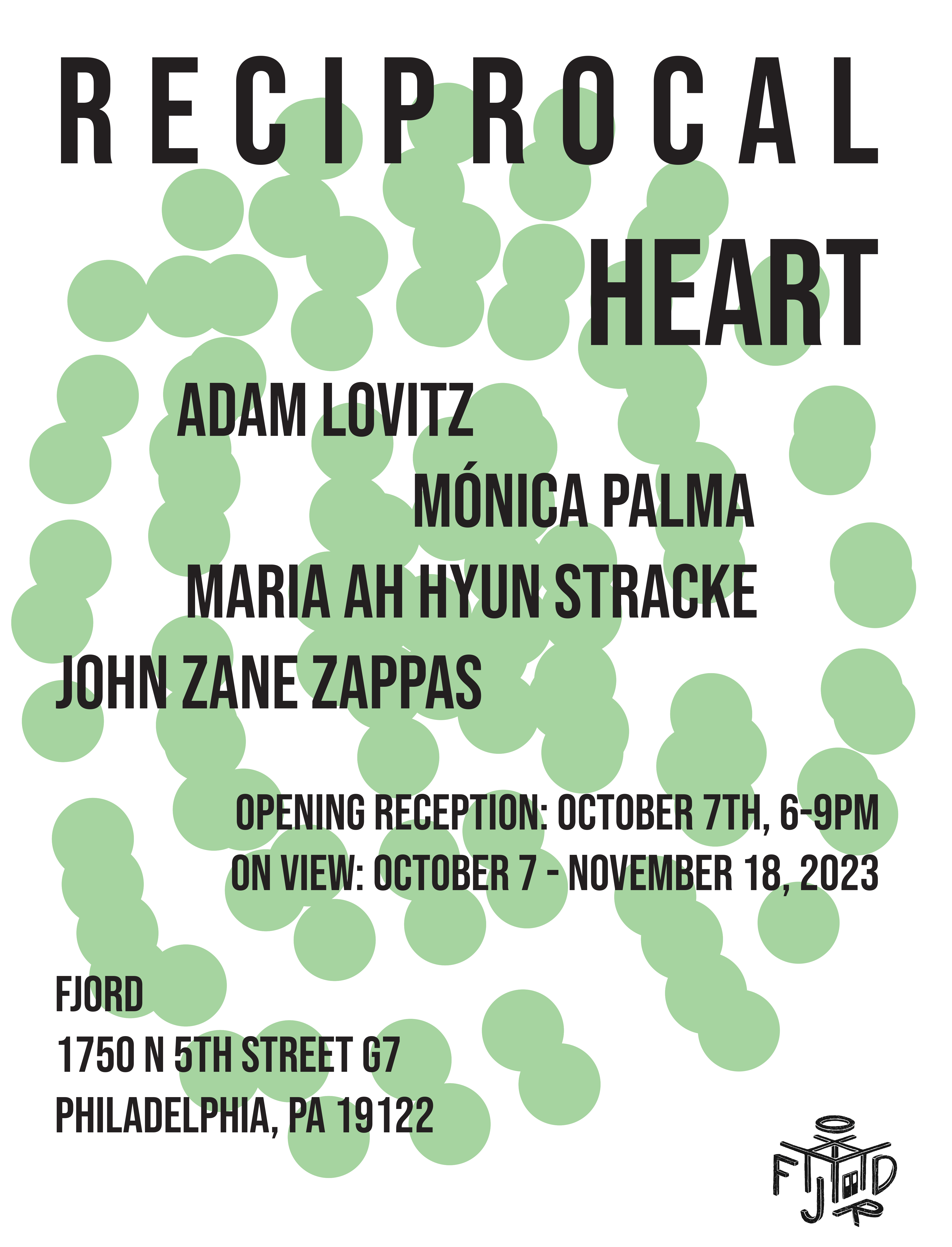7 October - 18 November 2023
Opening Reception:
Saturday, October 7, 6-9pm
Curated by Katie Wynne
︎ FJORD (1720 N 5th St G7)
Opening Reception:
Saturday, October 7, 6-9pm
Curated by Katie Wynne
︎ FJORD (1720 N 5th St G7)







FJORD is pleased to announce the opening of Reciprocal Heart, an exhibition of works by Adam Lovitz, Mónica Palma, Maria Ah Hyun Stracke, and John Zane Zappas.
Through tactile reconfigurations in drawing, painting, and sculpture, the artists featured in Reciprocal Heart reveal states of inward and outward relation to the world, offering the viewer joy, tenderness, and curiosity through the physicality of their work and practices. Reciprocal Heart is an exploration of materiality, hinged on the responsive relationship between people and objects, and the power of objects to be imbued with the conditions of our own hearts and minds. The stuff of the world is immense and unwieldy – rock, tar, paper, mdf, cactus, subway car, puddle, pez dispenser – and our reflection in these objects is equally complex. Through the arrangement of these varied forms, surfaces and textures, we may recognize, or obscure, our sense of self.
In Mónica Palma’s sculptural drawings fragile branches of huizache and mesquite plants, collected by the artist in her home country of Mexico, are centered and protected. These quick actions – which Palma calls “tokens” – surround these almost impossible-to-keep fragments in a profound gesture of care and remembrance. In another work by Palma, a rock dipped in tar acts as a makeshift pendulum hinting at our untold fate.
In Adam Lovitz’s work, paintings develop a sediment-like richness. Found objects are incorporated freely in his sculptural compositions, and equate the spectrum of family life or daily events from the seemingly mundane to the awe of natural phenomena and moments of existential depth. In the continuum of references Lovitz offers, we are as fried eggs and celestial bodies living in a shared space.
Maria Ah Hyun Stracke’s drawings are physical not only in their creation, but in their enveloping bodily and architectural scale. Stracke creates, deconstructs, repairs and reconfigures her large-scale paper works to develop deeply layered and complex spaces, enhanced by their installation hung slightly distanced from the wall. She mends and reconstructs her drawings with Korean hanji paper, allowing the slivers of space between cut and rejoined shapes to build an intuitively understood material language and an exploration of embedded histories and memory.
John Zane Zappas’s work gives visual form to internal time and thought, illustrating a quality of consciousness over representation. Often meditating before beginning a work, Zappas’s drawings feel like an exercise in refuting prescribed or known forms and embracing the joy and mystery of shape-making. Hefty oil stick marks may momentarily resemble bodies or plants – or if not plant forms than maybe plant habits, plant tendencies, plant humor – but the imagery continually slips, remaining entirely fluid to each new viewer’s perceptions and projections.
Through tactile reconfigurations in drawing, painting, and sculpture, the artists featured in Reciprocal Heart reveal states of inward and outward relation to the world, offering the viewer joy, tenderness, and curiosity through the physicality of their work and practices. Reciprocal Heart is an exploration of materiality, hinged on the responsive relationship between people and objects, and the power of objects to be imbued with the conditions of our own hearts and minds. The stuff of the world is immense and unwieldy – rock, tar, paper, mdf, cactus, subway car, puddle, pez dispenser – and our reflection in these objects is equally complex. Through the arrangement of these varied forms, surfaces and textures, we may recognize, or obscure, our sense of self.
In Mónica Palma’s sculptural drawings fragile branches of huizache and mesquite plants, collected by the artist in her home country of Mexico, are centered and protected. These quick actions – which Palma calls “tokens” – surround these almost impossible-to-keep fragments in a profound gesture of care and remembrance. In another work by Palma, a rock dipped in tar acts as a makeshift pendulum hinting at our untold fate.
In Adam Lovitz’s work, paintings develop a sediment-like richness. Found objects are incorporated freely in his sculptural compositions, and equate the spectrum of family life or daily events from the seemingly mundane to the awe of natural phenomena and moments of existential depth. In the continuum of references Lovitz offers, we are as fried eggs and celestial bodies living in a shared space.
Maria Ah Hyun Stracke’s drawings are physical not only in their creation, but in their enveloping bodily and architectural scale. Stracke creates, deconstructs, repairs and reconfigures her large-scale paper works to develop deeply layered and complex spaces, enhanced by their installation hung slightly distanced from the wall. She mends and reconstructs her drawings with Korean hanji paper, allowing the slivers of space between cut and rejoined shapes to build an intuitively understood material language and an exploration of embedded histories and memory.
John Zane Zappas’s work gives visual form to internal time and thought, illustrating a quality of consciousness over representation. Often meditating before beginning a work, Zappas’s drawings feel like an exercise in refuting prescribed or known forms and embracing the joy and mystery of shape-making. Hefty oil stick marks may momentarily resemble bodies or plants – or if not plant forms than maybe plant habits, plant tendencies, plant humor – but the imagery continually slips, remaining entirely fluid to each new viewer’s perceptions and projections.